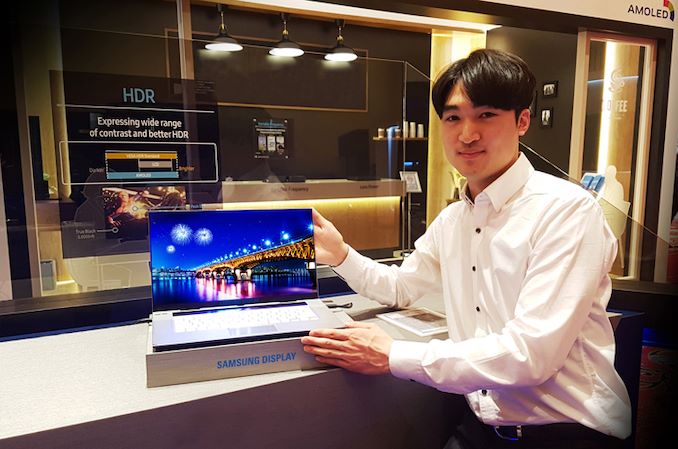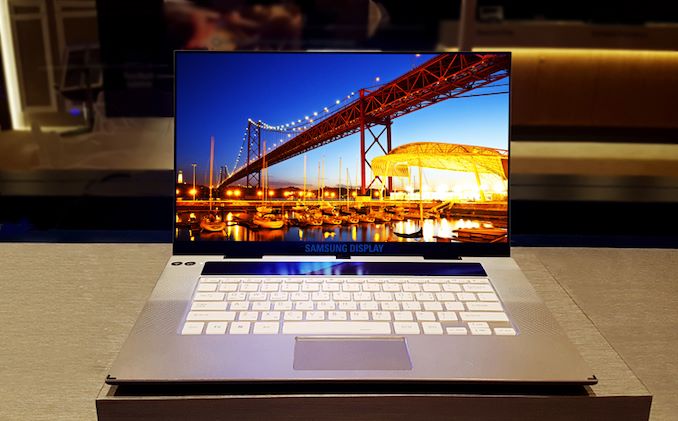Samsung Unveils 15.6-Inch Ultra-HD OLED Display for Laptops
by Anton Shilov on January 24, 2019 12:00 PM EST
Samsung has announced its 15.6-inch OLED monitor for notebooks. The Ultra-HD display features very advanced specs, will go into mass production next month, and will be used by leading makers of high-end notebooks later this year.
The Samsung 15.6-inch OLED monitor for notebooks relies on an Ultra-HD (3840×2160) OLED panel that boasts with a brightness level ranging from 0.0005 to 600 nits, a dynamic contrast ratio of 120,000:1, a very low response time, and wide horizontal viewing angles. The display can reproduce 100% of the DCI-P3 color gamut, which is considerably more more accurate when compared to LCDs available today. Furthermore, the monitor carries VESA’s DisplayHDR True Black badge thus supporting at least HDR10 spec.
| Specifications of Samsung's 15.6-Inch OLED Panel | |
| Specs | |
| Panel | 15.6" OLED |
| Native Resolution | 3840 × 2160 |
| Maximum Refresh Rate | ? |
| Response Time | unknown |
| Brightness | 0.0005 to 600 cd/m² |
| Contrast | 120,000:1 |
| Viewing Angles | ? |
| HDR | DisplayHDR True Black, HDR10 |
| Pixel Pitch | 0.0899 mm² |
| Pixel Density | 282 ppi |
| Display Colors | ? |
| Color Gamut Support | DCI-P3: 100% |
| Aspect Ratio | 16:9 |
| Mass Production Start | Mid-February-2019 |
An added bonus of any OLED monitor are very narrow display bezels, which will enable makers of notebooks to further miniaturize their 15.6-inch class laptops. In the meantime, keep in mind that the OLED technology is not ideal and has its own weaknesses, including off-axis color shifting, ghosting, burn-in, and other. So, only time will tell how good the new display from Samsung is.
Samsung will start mass production of its 15.6-inch OLED monitors for laptops in mid-February, so expect actual notebooks that use the display to hot the market later this year.
Back at CES, Lenovo and HP announced plans to use 15.6-inch AMOLED panels with their premium laptops in 2019, but did not confirm the source of their monitors.
Related Reading
- Lenovo at CES 2019: Yoga C730 Gets AMOLED Display
- HP at CES 2019: HP Spectre x360 15 Gets AMOLED Display
- Dell at CES 2019: Alienware 55-Inch 4K 120 Hz OLED Gaming Monitor Showcased
- New 8K OLED Displays for Tablets and Laptops: 8.3 and 13.3 Inches
- CES 2019: LG Announces Signature OLED TV R - A Rollable TV
- Lenovo Launches ThinkPad X1 Yoga At CES With OLED Display
- JOLED Demos 21.6-Inch OLED Monitor for Gamers
Source: Samsung











38 Comments
View All Comments
SaturnusDK - Tuesday, January 29, 2019 - link
Maybe you didn't understand me correctly. I use it for productivity work pretty much exclusively so yes, the screen doesn't get much rest during the day but it does a few hours each night. And that's the big difference between a laptop use case and the torture burn in tests. OLEDs are organic materials, as long as they're not stressed hard enough for some of the molecules to become inert then it regenerates itself. That the problem with using OLED TV burn in test and extrapolating any result from them to laptop use. It's a vastly different use case.On top of that most modern OLED monitor drivers are specifically configured to avoid running the OLED outside it's specifications. On a OLED TV that can be slightly annoying but very few people would enjoy sitting in front of a modern 400+ nits OLED laptop running full brightness at two-three feet distance from the screen if not in direct sunlight.
And that sends us right back to the typical operating conditions of a laptop, even a work laptop used heavily such as my own there is basically no chance of burn in ever happening unless you put it permanently on power supply, put it permanently on maximum brightness, don't use dark mode to make sure you absolutely stress the screen as much as you can, and then don't turn it off for 2 years like OLED TV burn in tests does.
HStewart - Monday, January 28, 2019 - link
I think the biggest issue with 4k on laptops now - is that consumes a lot of battery life. We are not talking about smaller phone screens here and I thinks it not just number of pixels but also physical size of screen.For me 4k on my Dell 15 2in1 is not always needed - but it would be nice if they made it use less power in smaller resolutions. But for me personally, the 2in1 is rarely used with out external monitor and docking station. But it nice to have when I do need.
Blue screen filters are nice to have also.
TEAMSWITCHER - Monday, January 28, 2019 - link
Avoid like the plague... The Windows Task Bar is the EXACT OPPOSITE of what you want on an OLED display. It will likely burn-in the first year. OLED's are a bad, bad idea for any computer usage.SaturnusDK - Monday, January 28, 2019 - link
The ignorance displayed in this section is staggering. Read my comment above. But to put it very simply, if used within normal operating conditions of a laptop burn in is virtually impossible. My own OLED laptop show no hint of burn in at all after 30 months of heavy use.fred.smith.1234 - Monday, January 28, 2019 - link
line 7: "considerably more more accurate"line 15: "considerably more more accurate"
Do you even proof read your article?!
fred.smith.1234 - Monday, January 28, 2019 - link
Maybe not seeing how I can't even copy and paste myself!line 15: "display to hot the market later".
Petersondm - Friday, May 3, 2019 - link
How will you tell the differences between the 15" OLED panels offered by each company? Alienware OLED seems to be lowest version when compared to Razer's OLED version. Alienware is HDR100, Not touch screen and Razer's is HDR400, touch screen. It would be interesting to know the hit to battery life as well.ZielonaHerbata - Monday, September 2, 2019 - link
hyperbook have this display in their laptop sl504. www.hyperbook.pl